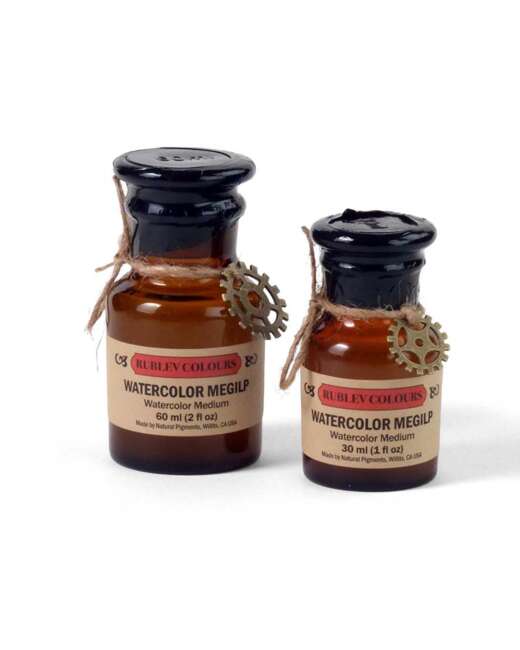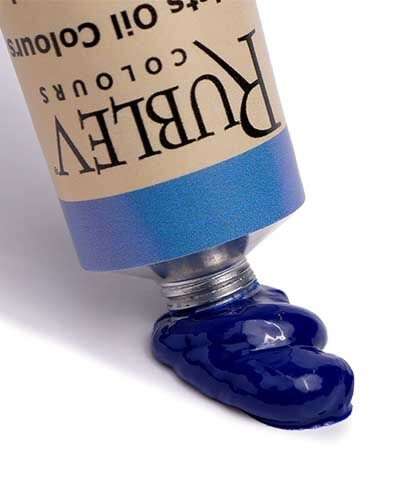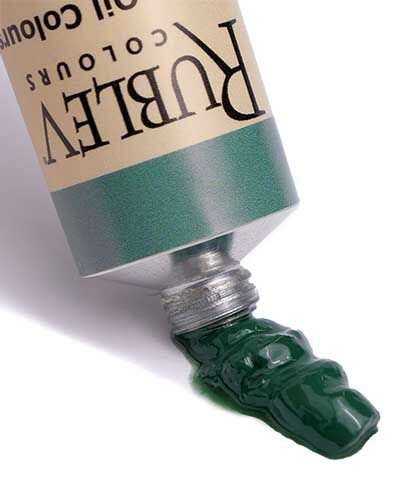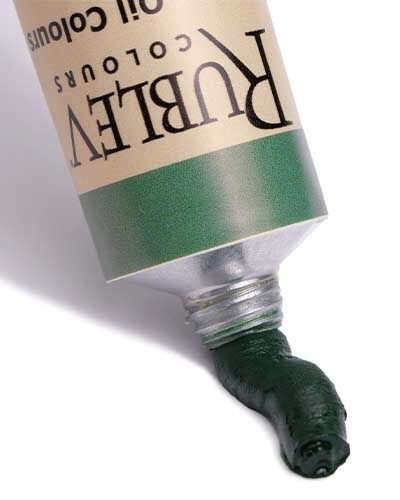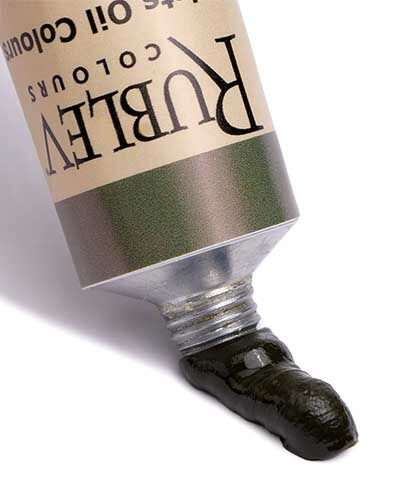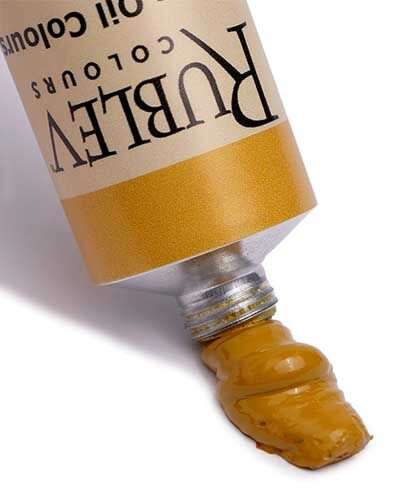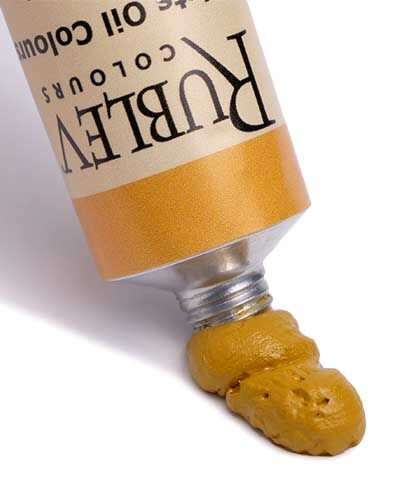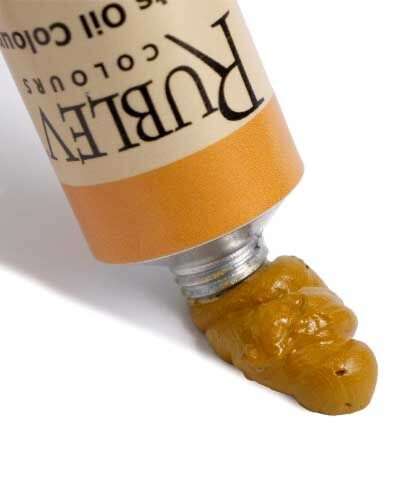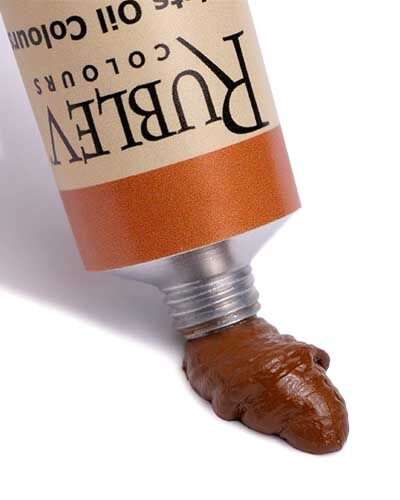Rublev Colours Artists Oils and Watercolors


Rublev Colours Artists’ Oils let you experience what the old masters well understood—the unique characteristics of pigments. The pigments used by old masters in their paintings were ground from natural minerals and earth, fermented in dyer vats, and concocted in alchemist laboratories. Rublev Colours Artists’ Oils give you the same pigments used by the old masters prepared with linseed oil as ready-made paints.
Most oil colors today are made to feel the same under the brush. Their consistency is short and buttery, irrespective of the color. Whereas a short and buttery consistency is good, there are many times when you want paint that has a different feel. Sometimes you need paint that flows. Other times you want a long and perhaps even ropey paint. Or one that flows when brushed and then thickens upon standing called thixotropic paint. That is why so many painters today resort to using mediums with their tube oil colors—to alter the consistency of their paint.
The Rublev Colours Difference
Why are Rublev Colours different from other commercial oil colors? One reason is that we use natural pigments or historical reproductions of pigments used by the old masters. Another reason is that we make Rublev Colours Artists’ Oils as they did before modern tube colors—without additives. Rublev Colours Artists’ Oils are formulated to maintain each oil pigment’s unique characteristics. The character found in each tube of our oil colors is unique due to the pigment inside, giving the artist nearly limitless choices of texture, opacity, consistency, tone, and hue. With Rublev Colours, you experience the transparency of yellow ochre, the pale coolness of green earth, and the crystalline glitter of deep blue azurite.
The particles of natural pigments are at least six times the diameter of synthetic pigments in modern artists’ colors. However, when we remember how predominantly crystalline or semi-crystalline pigments, such as azurite, malachite, lazurite, and so on, were used in old masters’ paintings, it is easy to understand how these beautiful surfaces with broken lights were obtained. An examination, for instance, of the surface of azurite blue under the microscope at once reveals the beautiful mass of blue and blue-green crystals, reflecting light in all directions and thus, of course, enhancing the decorative effect.
Pure Oil Color, No Additives
Rublev Colours Artists’ Oils do not contain additives, such as fillers, driers, and stabilizers—simply pigment and oil. We use refined linseed oil in our paint, sometimes with a small amount of heat-bodied linseed oil. Stabilizers, such as stearates and waxes, are not added that diminish the individual effects of pigments in oil. Therefore, you will find different consistencies from color to color due to the individual pigment characteristics and an occasional bit of free oil. Some colors brush out long, others short and buttery, and others are thixotropic.
Some separation of pigment and oil may occur with Rublev Colours and is a natural process when no stabilizers are added to oil paint to prevent this from occurring.
Overall, Rublev Colours Artists’ Oils have longer brushing consistency than most tube colors available today, making them ideal for both bristle and soft-hair brushes in fine rendering, with old master-like effects on both fine-weave canvas and smooth panels.
Single Pigment Colors
When you see a color name on our label, you get just that—one pure pigment. You will not find “hues” among Rublev Colours. No “Vermilion Hue,” simply pure red mercuric sulfide. When you buy a tube of Rublev “Green Earth” from Natural Pigments, you are not getting a mixture of green chromium oxide, unidentified earth color, and barium sulfate; you get the real thing—green earth. When you buy “Rublev Vermilion,” we don’t give you cadmium red. And our Naples yellow is not an indeterminate mixture of pigments but pure lead antimonate. You won’t even find the word “genuine” used to describe Rublev Colours because all of our pigments are simply that—genuine.
All our earth colors have outstanding lightfastness, and most others are permanent when used at full strength. Rublev Colours Artists’ Oils offer an extraordinary range of tinting strength and an immense diversity between opacity and transparency.
Individually Made, Meticulously Crafted
We make Rublev Colours Artists’ Oils in small batches, typically only five gallons at a time, meticulously crafting each color. Using natural mineral pigments means we must take extra steps to prepare these colors into usable paint, which is typically not required for modern synthetic pigments. All this requires more time and labor to make a finished product that is different from other oil colors—a difference you can clearly see and palpably feel.
How We Make Rublev Colours Artists’ Oils
From our extensive experience making pigments, we select those that not only make good colors in oil but provide a diverse range of texture, body, and opacity. Some pigments, such as indigo, are purified further using old masters’ recipes to increase lightfastness. We then prepare each pigment by baking them in low-temperature ovens for several days to remove all traces of moisture.
Next, we mix the pigment with oil, usually linseed, in mixers or, in the case of some mineral pigments, in edge runners resembling old-fashioned stone mills to obtain a denser, homogenous mixture. The paste, called a premix, is allowed to “sweat” overnight or longer before grinding.
The paste is ground on three-roll mills made of stone rolls or chilled cast steel. The steel rolls are water-cooled to prevent the premix from overheating. We grind each color at least 3 or 4 times, reducing the gap between the rolls to apply more significant pressure on the paste. We grind our paints more times than other manufacturers because we do not use additives, such as stearates or waxes, that while making paint easier to grind, alter the body and consistency of the paint. Often colors are ground 6 to 8 times before we consider them ready.
Finally, before filling tubes or cans, we check each batch for tinting strength, consistency, and density.
Rublev Colours Watercolors
Rublev Colours Watercolors are made with the same pigments used by watercolor masters of the 17th to 19th centuries. The colors are genuine single-pigment paints available individually in 20 ml tubes and cakes.
We make Rublev Colours Watercolors in small batches using gum arabic and sugar syrup, which were the essential ingredients in watercolors of past centuries. There are no other additives to alter the characteristics of each color. Rublev Colours Watercolors do not contain fillers to extend colors, dispersants to disperse granulate pigments, and brighteners to intensify colors. Instead, each color is crafted to develop its unique character, so they behave much the same as the colors of past masters.
We use gum from Acacia trees and clarify it with activated charcoal to make a pale gum arabic solution. Honey and sugar syrup has been used throughout history as an ingredient in water-based paint to prevent it from drying quickly. Colors made with these ingredients do not dry quickly and are easier to dilute.
Lightfastness
According to ASTM lightfastness standards, most Rublev Colours Watercolors are rated I or II, showing little or no change in watercolors. Those of the lightfastness III category may be sufficiently lightfast if they are provided with extra protection from UV light.
Staining
Staining is the characteristic that makes color challenging to remove from the paper after it has been applied. Less staining colors can be lightened or removed almost entirely when wet or when rewetted, lifted with a clean, wet brush, and blotted up with a paper towel. Staining largely depends on the paper and the particle size of the pigment. Dispersants increase staining because they embed pigment particles in the fibers of the paper, dulling the finished color. While most brands of watercolors contain dispersants, Rublev Colours Watercolors do not; so staining is minimized.
Granulation
Granulation is the appearance of visible pigment particles in the applied color, especially when the paint is diluted and applied with a wet brush.
Flocculation
Flocculation is the clumping together of pigment particles, typical of some colors, such as lapis lazuli. Both granulation and flocculation create subtle effects as the paint dries and are considered desirable by accomplished watercolorists. The trend in commercial watercolors is to suppress pigment textures in favor of homogeneous washes of color. Many of the pigments used in Rublev Colours Watercolors are composed of large particles and produce granulation effects naturally without the use of additives.
Notes About Rublev Colours Artists’ Paints
Color Swatches

Rublev Colours Artists’ Oils: Madder Lake Swatch
The color swatches in this website were created by showing a thin tint of the color mixed with an equal part of linseed oil (left), a solid thick application (middle), and a solid half tint mixed with an equal amount of lead white (right) applied onto acrylic primed canvas (7 ounces). All pictures of color swatches on this website are only approximations of the actual color of the oil paint. We have carefully matched the color in these pictures on calibrated color monitors to the actual color. However, because of the wide variance in color monitors, the color you see may differ.
Color Descriptions
To help you select colors from our store, we have organized our oil colors according to their basic color, and the origin of the pigment used to make the color.
Each color in our store is listed by the name of the pigment, in the case of mineral variations, of its most common color name, and if there exists a synthetic substitute, the common name of the artificial pigment. Common names in other languages and alternative and obsolete color names are also provided because many inquiries begin with obscure and little-used color names.
The information for each color in the store is as follows: name of the color, binder, Colour Index name, chemical name, chemical formula, ASTM lightfastness rating, if available, opacity, tinting strength, drying rate, and toxicity alerts.
Lightfastness
Information on each color includes an ASTM lightfastness category in oil where test data is available:
| ASTM | Lightfastness |
|---|---|
| I | Excellent lightfastness |
| II | Very good lightfastness |
| III | Sufficiently lightfast |
Colors falling in the lightfastness III category are considered sufficiently lightfast only if they are used full strength (not tinted with white) and are provided with extra protection from ultraviolet light (such as protecting with a UV-absorbent varnish).



